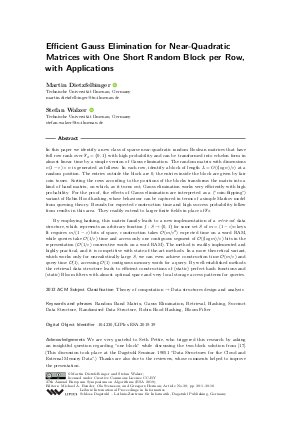@InProceedings{dietzfelbinger_et_al:LIPIcs.ESA.2019.39,
author = {Dietzfelbinger, Martin and Walzer, Stefan},
title = {{Efficient Gauss Elimination for Near-Quadratic Matrices with One Short Random Block per Row, with Applications}},
booktitle = {27th Annual European Symposium on Algorithms (ESA 2019)},
pages = {39:1--39:18},
series = {Leibniz International Proceedings in Informatics (LIPIcs)},
ISBN = {978-3-95977-124-5},
ISSN = {1868-8969},
year = {2019},
volume = {144},
editor = {Bender, Michael A. and Svensson, Ola and Herman, Grzegorz},
publisher = {Schloss Dagstuhl -- Leibniz-Zentrum f{\"u}r Informatik},
address = {Dagstuhl, Germany},
URL = {https://drops.dagstuhl.de/entities/document/10.4230/LIPIcs.ESA.2019.39},
URN = {urn:nbn:de:0030-drops-111602},
doi = {10.4230/LIPIcs.ESA.2019.39},
annote = {Keywords: Random Band Matrix, Gauss Elimination, Retrieval, Hashing, Succinct Data Structure, Randomised Data Structure, Robin Hood Hashing, Bloom Filter}
}

 Creative Commons Attribution 3.0 Unported license
Creative Commons Attribution 3.0 Unported license



